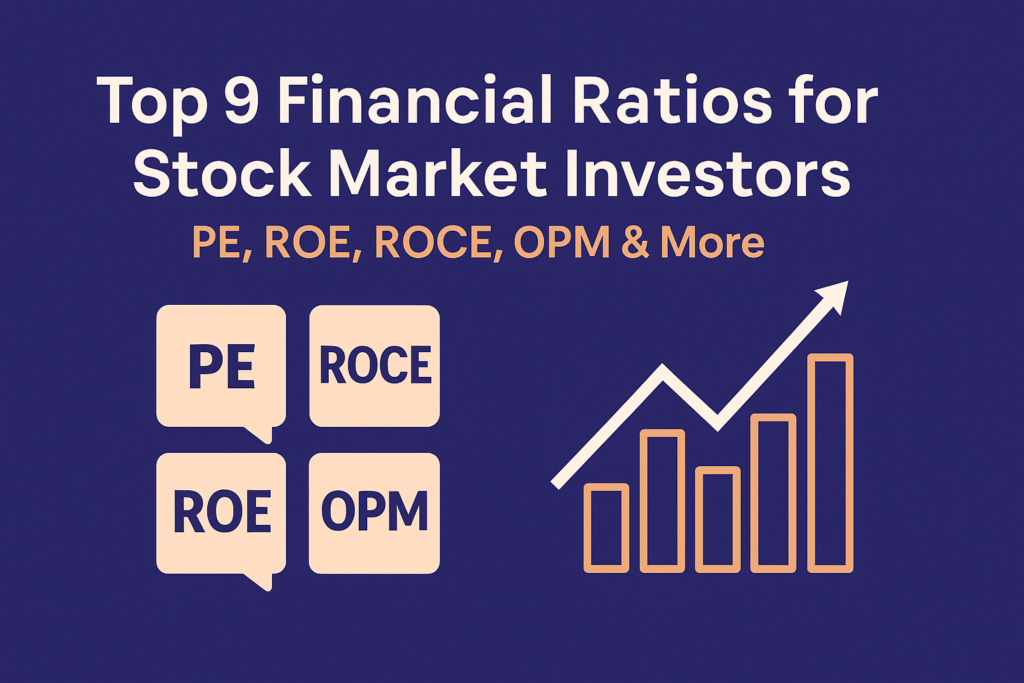

Top 9 Financial Ratios for Stock Market Investors: PE, ROE, ROCE, OPM & More
If you’re starting your journey in the stock market or looking to improve your understanding of financial analysis, there are a few key terms you must know. Metrics like Market Cap, P/E Ratio, ROE, ROCE, and others play a vital role in evaluating companies for investment.
📌 1. What is Market Capitalization (Market Cap) and How It Works? Market cap meaning, how market cap is calculated, large cap vs small cap
Market Capitalization, or Market Cap, represents the total value of a publicly listed company’s outstanding shares.
💡 Formula:
Market Cap = Share Price × Total Number of Outstanding Shares
🧠 How It Works:
- A company with 10 crore shares trading at ₹100 each will have a market cap of ₹10,000 crore.
- It’s used to classify companies as Large Cap, Mid Cap, or Small Cap.
- It helps investors compare company size and assess relative risk.
Also Read; What is a Credit Card?& How Banks Make Money?
📌 2. What is PE Ratio (Price to Earnings) and How It Works? PE ratio explained, good PE ratio, how PE ratio works in stocks
Price-to-Earnings (P/E) Ratio shows how much investors are willing to pay for ₹1 of the company’s earnings.
💡 Formula:
P/E Ratio = Market Price per Share / Earnings per Share (EPS)
🧠 How It Works:
- A high P/E may suggest overvaluation or high growth expectations.
- A low P/E may indicate undervaluation or poor future growth.
- Compare P/E with peers and historical values to make judgments.
📌 3. What is ROE (Return on Equity) and How It Works? what is ROE in stocks, return on equity formula, ROE interpretation
Return on Equity (ROE) measures how efficiently a company generates profit from shareholders’ equity.
💡 Formula:
ROE = Net Profit / Shareholder’s Equity × 100
🧠 How It Works:
- A high ROE means better capital efficiency.
- Useful for comparing companies within the same industry.
- Avoid companies with consistently declining ROE.
📌 4. What is ROCE (Return on Capital Employed) and How It Works? ROCE vs ROE, return on capital employed, how to calculate ROCE
ROCE measures a company’s profitability based on its total capital (equity + debt).
💡 Formula:
ROCE = EBIT / Capital Employed × 100
Where:
- EBIT = Earnings Before Interest and Taxes
- Capital Employed = Total Assets – Current Liabilities
🧠 How It Works:
- Helps assess how well a company uses both equity and debt to generate profits.
- More comprehensive than ROE for capital-intensive businesses.
Also Read;शून्य निवेश; बिजनेस आइडिया और निष्पादन रणनीति रणनीति
📌 5. What is Pledge of Equity and How It Works? Pledged shares meaning, promoter pledge risk, what is equity pledge
A Pledge of Equity means promoters have used their shares as collateral to raise loans.
🧠 How It Works:
- If promoters fail to repay, lenders may sell shares, impacting stock price.
- High pledged shares = higher risk.
- Prefer companies with 0% or low promoter pledge.
📌 6. What is Dividend Payout and How It Works? dividend payout ratio, dividend income, best dividend stocks
Dividend Payout is the portion of net profit distributed to shareholders as dividends.
💡 Formula:
Dividend Payout Ratio = Dividend / Net Profit × 100
🧠 How It Works:
- High payout: Good for income investors but may limit growth.
- Low payout: More profits reinvested for expansion.
- Consistent dividend-paying companies are seen as stable.
📌 7. What is Debt-to-Equity Ratio and How It Works? debt equity ratio analysis, low debt companies, how much debt is safe
Debt-to-Equity (D/E) Ratio indicates how much debt a company has compared to shareholders’ equity.
💡 Formula:
D/E Ratio = Total Debt / Shareholder’s Equity
🧠 How It Works:
- D/E > 1: More debt than equity (risky for some industries).
- D/E < 1: Safer leverage levels.
- Ideal D/E varies by sector — capital-intensive industries may tolerate higher D/E.
📌 8. What is Cash Flow and How It Works? cash flow explained, cash flow vs profit, operating cash flow formula
Cash Flow refers to the net amount of cash coming in and out of a business.
🧠 Types:
- Operating Cash Flow (OCF) – From core operations
- Investing Cash Flow (ICF) – From asset sales/purchases
- Financing Cash Flow (FCF) – From borrowing, share issues, dividends
🧠 How It Works:
- Positive Operating Cash Flow = healthy business.
- Negative OCF = potential red flag despite profit on paper.
📌 9. What is OPM (Operating Profit Margin) and How It Works? OPM in stocks, how to calculate OPM, profit margin analysis
Operating Profit Margin (OPM) indicates how much operating profit a company makes per ₹1 of revenue.
💡 Formula:
OPM = Operating Profit / Revenue × 100
🧠 How It Works:
- High OPM means better cost control and efficiency.
- Compare OPM across years and with peers in the same industry.
- Declining OPM may signal rising costs or lower pricing power.
🏁 Final Thoughts; Top 9 Financial Ratios for Stock Market Investors: PE, ROE, ROCE, OPM & More.
Understanding these financial ratios and metrics is crucial for making smarter investment decisions. Each of these indicators — Market Cap, P/E, ROE, ROCE, Pledged Shares, Dividends, Debt-Equity, Cash Flow, and OPM — tells a story about a company’s health, efficiency, and risk profile.
Whether you’re investing in blue-chip stocks or exploring small caps, these fundamentals will help you analyze with confidence.
🔍 Frequently Asked Questions (FAQs) Top 9 Financial Ratios for Stock Market Investors: PE, ROE, ROCE, OPM & More.
✅ What is the most important financial ratio for stock analysis?
There’s no single answer. For profitability: ROE/ROCE; for valuation: P/E ratio; for debt: D/E ratio.
✅ What is a good ROE and ROCE?
Generally, ROE > 15% and ROCE > 12% are considered good, but it varies by sector.
✅ Is high PE always bad?
Not necessarily. Growth companies often have high P/E ratios. It must be compared with peers and future earnings potential.
Top 9 Financial Ratios for Stock Market Investors: PE, ROE, ROCE, OPM & More.



